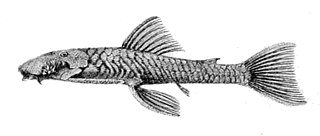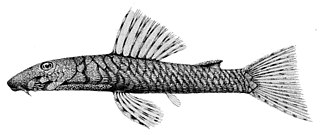
Ancistrus is a genus of nocturnal freshwater fish in the family Loricariidae of order Siluriformes, native to freshwater habitats in South America and Panama. Fish of this genus are common in the aquarium trade where they are known as bushynose or bristlenose catfish. In the aquarium hobby they are often referred to as bushynose or bristlenose plecos instead, but this may lead to confusion as "pleco" usually is used for Hypostomus plecostomus and its allies and is often used as a catchall term for any loricariids remotely resembling that species.

The Magdalena River is the main river of Colombia, flowing northward about 1,528 kilometres (949 mi) through the western half of the country. It takes its name from the biblical figure Mary Magdalene. It is navigable through much of its lower reaches, in spite of the shifting sand bars at the mouth of its delta, as far as Honda, at the downstream base of its rapids. It flows through the Magdalena River Valley.

Ancistrus caucanus is a species of catfish in the family Loricariidae. It is native to South America, where it was at one point thought to occur in the Cauca River basin in Colombia, for which it is named, although subsequent research suggested in 2013 that it is actually native to the Magdalena River basin, whereas its congener Ancistrus vericaucanus is the species native to the Cauca. The species reaches 5.2 cm SL. It is not to be confused with the similarly named species Lasiancistrus caucanus.
Ancistrus sericeus is a species of catfish in the family Loricariidae. It is native to South America, where it occurs in the basin of the Ampiyacu River, a tributary of the Amazon River, in Peru. The species reaches 5 cm SL.
Ancistrus centrolepis is a species of catfish in the family Loricariidae. It is a freshwater species native to South America, where it occurs in coastal drainages of the northern Andes, including the Atrato River, Baudó River, and San Juan River basins in Colombia. The species reaches 18.4 cm SL.
Ancistrus chagresi is a species of catfish in the family Loricariidae. It is native to Central America, where it occurs near the Panama Canal in the basins of the Chagres River, the Chorrera River, and the Gatún River. The species reaches 19.5 cm SL.
Ancistrus parecis is a species of catfish in the family Loricariidae. It is native to South America, where it occurs in the Tapajós River basin in Brazil. Its specific epithet refers to the Parecis Plateau, where the type specimen was collected. The species reaches 6 cm (2.4 in) SL.
Ancistrus amaris is a species of catfish in the family Loricariidae. It is native to South America, where it occurs in the Orinoco River and Apure River basins in Venezuela. The species reaches at least 11.57 cm (4.56 in) SL and was described in 2019 by Lesley S. de Souza of the Field Museum of Natural History, Donald C. Taphorn of the Royal Ontario Museum, and Jonathan Armbruster of Auburn University alongside five other species of Ancistrus.

Ancistrus greeni is a species of catfish in the family Loricariidae. It is native to South America, where it occurs in the Madre de Dios River and Inambari River basins in Peru. The species reaches 6.5 cm in total length.
Ancistrus saudades is a species of catfish in the family Loricariidae. It is native to South America, where it occurs in the basins of the Takutu River, the Ventuari River, the Caroní River, and the Caura River in Guyana, Venezuela, and Brazil. The species reaches at least 10.75 cm (4.23 in) SL and was described in 2019 by Lesley S. de Souza of the Field Museum of Natural History, Donald C. Taphorn of the Royal Ontario Museum, and Jonathan Armbruster of Auburn University alongside five other species of Ancistrus.
Ancistrus bodenhameri is a species of catfish in the family Loricariidae. It is native to South America, where it occurs in tributaries of Lake Maracaibo in Venezuela. The species reaches 11.4 cm SL.
Ancistrus yutajae is a species of catfish in the family Loricariidae. It is native to South America, where it occurs only in the Yutajé River in Venezuela. The species reaches at least 8.28 cm (3.3 in) SL and was described in 2019 by Lesley S. de Souza of the Field Museum of Natural History, Donald C. Taphorn of the Royal Ontario Museum, and Jonathan Armbruster of Auburn University alongside five other species of Ancistrus.
Ancistrus heterorhynchus is a species of catfish in the family Loricariidae. It is native to South America, where it occurs in the Inambari River basin, which is part of the Madre de Dios River drainage in Peru. The species reaches 6.3 cm SL and is known to inhabit high-altitude areas.
Ancistrus lineolatus, also known as the Bristlenose Catfish is a species of catfish in the family Loricariidae. It is native to South America, where it occurs in the Orteguaza River basin, which is part of the Japurá River drainage in Colombia.

Ancistrus marcapatae is a species of catfish in the family Loricariidae. It is native to South America, where it occurs in the Inambari River basin, which is part of the Madeira River drainage in Peru. The species reaches 12.4 cm in total length.
Ancistrus reisi is a species of catfish in the family Loricariidae. It is a freshwater fish native to South America, where it is known to occur in small rivers in the state of Tocantins in Brazil. The species reaches 6.1 cm SL and is distinguished from most members of the genus by the absence of an adipose fin, which for this species is replaced by a series of unpaired platelets that form a low crest.
Ancistrus verecundus is a species of catfish in the family Loricariidae. It is native to South America, where it occurs in the Madeira River basin in Brazil. The species reaches 5.5 cm SL. Its specific epithet, verecundus, derives from Latin and means "modest" or "bashful", referencing the absence or reduced presence of tentacles on the snout of the species.
Ancistrus vericaucanus is a species of catfish in the family Loricariidae. It is native to South America, where it occurs in the basin of the Cauca River, which is a tributary of the Magdalena River, in Colombia. It reaches 7.2 cm SL. Its congener Ancistrus caucanus was once thought to inhabit the Cauca River basin and was named after the river itself, but it was determined in 2013 that A. caucanus was not actually native to the Cauca. The specific epithet of A. vericaucanus means "true caucanus", in reference to the misleading name of A. caucanus.





